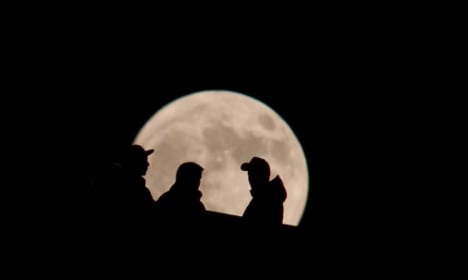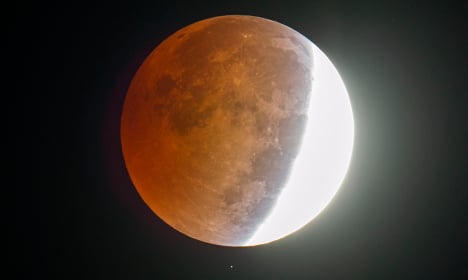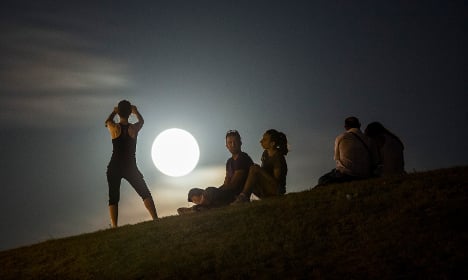Why you should stay up for Sweden's supermoon

If you gaze up to the Nordic sky on Sunday night you'll have the chance to see not just one but two celestial phenomena: a total lunar eclipse and a so-called supermoon.
What is a supermoon?
A supermoon is when a full moon coincides with the celestial body reaching its closest point to Earth on its elliptical orbit around us. Some astronomers frown on the term 'supermoon' and prefer to use its technical name: 'perigee-syzygy of the Earth-Moon-Sun system'. Admittedly not as catchy.
To be more exact, on Monday the full moon will be about 356,000 kilometres from the Earth, as opposed to its usual average distance of some 382,900 kilometres. You could almost reach out and touch it. Er, almost.

The moon will look bigger and brighter than normal. Photo: Alexander Vestrum/NTB scanpix
Why is this one special?
Because it coincides with a total lunar eclipse which will see the moon develop an impressively reddish colour, often referred to as a 'blood moon'. This one is the final in a series of four consecutive total lunar eclipses, each separated from the other by six months, with no partial eclipses in between – a so-called 'tetrad'.
There's a number of prophecies suggesting the phenomenon signifies the beginning of the apocalypse. We think it's mainly just going to be pretty to look at.

A lunar eclipse above the US in 2014. Photo: AP Photo/The Fayetteville Observer, Johnny Horne
What will I see?
Well, the moon, pretty much. Just bigger and brighter – and as the night progresses, redder – than average. Here's what Swedish astronomer Peter Linde told tablid Expressen earlier this week: "It will be perceived as a lot bigger, but it's actually just eight percent closer than its average distance." And Sweden is just the place to watch it: because it's so far north the moon will be closer to the horizon, making it look even bigger.
As the lunar eclipse begins, the Earth will bit by bit cover the moon until it completely shadows it. But some sunlight will still be able to get through the atmosphere, which is what causes the moon's red colour.
There will be a #SuperBloodMoon this weekend, but what does that mean? Let us explain: http://t.co/EpK9kNPPoH pic.twitter.com/MyCqwZnrtq
— NASA (@NASA) September 25, 2015
When should I go outside?
If you normally find it a struggle to get out of bed on a Monday morning, you probably want to set several alarms for this one. Or just stay up all night. Look to the west as the spectacle begins to unfold shortly before 3am. The lunar eclipse will be the most visible at 5am.
"If you peek outside just before 6am you will get a sense of what you could have experienced. If you wait until 6.30am it will almost be over," according to Robert Cumming, astronomer at the Onsala observatory in Sweden, told Swedish Radio.
Temperatures will be below 10C, so don't forget to put a jacket on over your pyjamas.

This is in Spain. If it had been in Sweden they would have had their jackets on. Photo: AP Photo/Andres Kudacki
When will I see one again?
Depends what you're looking for. The next supermoon, according to the Time and Date website, is set for November 14th 2016, and you'll be likely to spot the next total lunar eclipse in Sweden in 2018.
However, a supermoon coinciding with a lunar eclipse is fairly rare. It happened last in 1982 and it will not happen again until the 2030s.
Comments
See Also
What is a supermoon?
A supermoon is when a full moon coincides with the celestial body reaching its closest point to Earth on its elliptical orbit around us. Some astronomers frown on the term 'supermoon' and prefer to use its technical name: 'perigee-syzygy of the Earth-Moon-Sun system'. Admittedly not as catchy.
To be more exact, on Monday the full moon will be about 356,000 kilometres from the Earth, as opposed to its usual average distance of some 382,900 kilometres. You could almost reach out and touch it. Er, almost.

The moon will look bigger and brighter than normal. Photo: Alexander Vestrum/NTB scanpix
Why is this one special?
Because it coincides with a total lunar eclipse which will see the moon develop an impressively reddish colour, often referred to as a 'blood moon'. This one is the final in a series of four consecutive total lunar eclipses, each separated from the other by six months, with no partial eclipses in between – a so-called 'tetrad'.
There's a number of prophecies suggesting the phenomenon signifies the beginning of the apocalypse. We think it's mainly just going to be pretty to look at.

A lunar eclipse above the US in 2014. Photo: AP Photo/The Fayetteville Observer, Johnny Horne
What will I see?
Well, the moon, pretty much. Just bigger and brighter – and as the night progresses, redder – than average. Here's what Swedish astronomer Peter Linde told tablid Expressen earlier this week: "It will be perceived as a lot bigger, but it's actually just eight percent closer than its average distance." And Sweden is just the place to watch it: because it's so far north the moon will be closer to the horizon, making it look even bigger.
As the lunar eclipse begins, the Earth will bit by bit cover the moon until it completely shadows it. But some sunlight will still be able to get through the atmosphere, which is what causes the moon's red colour.
There will be a #SuperBloodMoon this weekend, but what does that mean? Let us explain: http://t.co/EpK9kNPPoH pic.twitter.com/MyCqwZnrtq
— NASA (@NASA) September 25, 2015
When should I go outside?
If you normally find it a struggle to get out of bed on a Monday morning, you probably want to set several alarms for this one. Or just stay up all night. Look to the west as the spectacle begins to unfold shortly before 3am. The lunar eclipse will be the most visible at 5am.
"If you peek outside just before 6am you will get a sense of what you could have experienced. If you wait until 6.30am it will almost be over," according to Robert Cumming, astronomer at the Onsala observatory in Sweden, told Swedish Radio.
Temperatures will be below 10C, so don't forget to put a jacket on over your pyjamas.

This is in Spain. If it had been in Sweden they would have had their jackets on. Photo: AP Photo/Andres Kudacki
When will I see one again?
Depends what you're looking for. The next supermoon, according to the Time and Date website, is set for November 14th 2016, and you'll be likely to spot the next total lunar eclipse in Sweden in 2018.
However, a supermoon coinciding with a lunar eclipse is fairly rare. It happened last in 1982 and it will not happen again until the 2030s.
Join the conversation in our comments section below. Share your own views and experience and if you have a question or suggestion for our journalists then email us at [email protected].
Please keep comments civil, constructive and on topic – and make sure to read our terms of use before getting involved.
Please log in here to leave a comment.